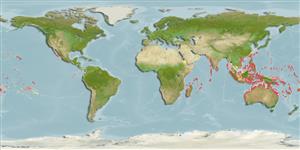Environment: milieu / climate zone / depth range / distribution range
Ecologie
marien rifbewoner; diepte 1 - 25 m (Ref. 90102). Tropical; 28°N - 32°S
Indo-West Pacific: Mauritius to Fiji, north to the Ryukyu Islands, south to Western Australia and the Great Barrier Reef. Recently recorded from Tonga (Ref. 53797).
Grootte / Gewicht / Leeftijd
Maturity: Lm ? range ? - ? cm
Max length : 31.0 cm TL mannelijk / geslacht onbekend; (Ref. 9710)
Dorsale stekels (totaal): 9; Dorsale zachte stralen (totaal): 11-13; Anale stekels 3; Anale zachte stralen: 11 - 13. Color of Philippine `pterophthalmus' form very dark olive-brown; scales with reddish margins; body without markings. Male form (painting) reddish brown, each scale with a vertical blue line; irregular blue lines on head and thorax; median fins with spots or stripes and colored margins. Dorsal spines pungent. Caudal fin rounded in juveniles. Juveniles with large ocelli at the ends of the dorsal and anal fins (Ref. 48636).
Adults inhabit shallow coral reefs, often in weedy areas (Ref. 9710). Feed on benthic invertebrates. Expatriate juveniles are transported by currents to subtropical zones during pelagic stages (Ref. 48636). Oviparous, distinct pairing during breeding (Ref. 205). Occasionally seen in fish markets or aquarium trade.
Levenscyclus en paargedrag
Maturiteit | Voortplanting | Paaien | Eieren | Fecunditeit | Larven
Pelagic spawner (Ref. 32193). Oviparous, distinct pairing during breeding (Ref. 205). Protogyny was proposed but not confirmed (Ref. 103751).
Westneat, M.W., 2001. Labridae. Wrasses, hogfishes, razorfishes, corises, tuskfishes. p. 3381-3467. In K.E. Carpenter and V. Niem (eds.) FAO species identification guide for fishery purposes. The living marine resources of the Western Central Pacific. Vol. 6. Bony fishes part 4 (Labridae to Latimeriidae), estuarine crocodiles. FAO, Rome. (Ref. 9823)
Status op de Rode Lijst van het IUCN (Ref. 130435)
Gevaar voor de mens
Harmless
Gebruik door de mens
Visserij: van minder commercieel belang; Aquarium: Commercieel
Meer informatie
ReferentiesAquacultuurAquacultuurprofielKweeklijnenGeneticaElectrophoresesErfelijkheidZiektesVerwerkingNutrientsMassaconversie
Tools
Speciale rapporten
Download XML
Internetbronnen
Estimates based on models
Preferred temperature (Ref.
123201): 24.6 - 29.3, mean 28.3 °C (based on 2750 cells).
Fylogenetische diversiteitsindex (Ref.
82804): PD
50 = 0.5002 [Uniqueness, from 0.5 = low to 2.0 = high].
Bayesian length-weight: a=0.00977 (0.00470 - 0.02030), b=3.07 (2.89 - 3.25), in cm total length, based on LWR estimates for this (Sub)family-body shape (Ref.
93245).
Trofisch niveau (Ref.
69278): 3.5 ±0.50 se; based on food items.
Weerstandsvermogen (Ref.
120179): Gemiddeld, minimale populatieverdubbelingstijd 1,4-4,4 jaar (Preliminary K or Fecundity.).
Fishing Vulnerability (Ref.
59153): Low vulnerability (21 of 100).
Nutrients (Ref.
124155): Calcium = 53.3 [32.7, 85.7] mg/100g; Iron = 0.589 [0.348, 1.061] mg/100g; Protein = 18.6 [15.7, 20.8] %; Omega3 = 0.135 [0.090, 0.201] g/100g; Selenium = 25.5 [16.2, 43.8] μg/100g; VitaminA = 113 [36, 394] μg/100g; Zinc = 1.4 [1.0, 2.2] mg/100g (wet weight);
